Myxedema coma - Study guides, Class notes & Summaries
Looking for the best study guides, study notes and summaries about Myxedema coma? On this page you'll find 1608 study documents about Myxedema coma.
Page 2 out of 1.608 results
Sort by
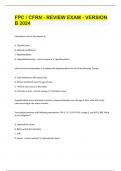
-
FPC / CFRN - REVIEW EXAM - VERSION B 2024
- Exam (elaborations) • 46 pages • 2024
-
 YANCHY
YANCHY
-
- $16.49
- + learn more
FPC / CFRN - REVIEW EXAM - VERSION B 2024 Myxedema coma is also known as... A. Thyroid storm B. Adrenal insufficiency C. Hypothyroidism D. Hyperaldosteronism - correct answer Hypothyroidism Most common presentation of a patient with hypothyroidism are all of the following, Except... A. Cold intolerance with coarse hair B. Almost exclusively over the age of sixty C. >90% of cases occur in the winter D. Primarily in men - correct answer Primarily in men Hypothroidism occu...
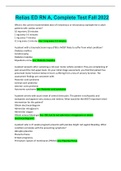
-
(answered)Relias ED RN A, Complete Test 2024 Updated with 100% Correct and Verified Answers.
- Exam (elaborations) • 13 pages • 2022
-
Available in package deal
-
 dennys
dennys
-
- $10.89
- 54x sold
- + learn more
Relias ED RN A, Complete Test Fall 2024 with correct answers What is the current recommended dose of intravenous or intraosseous epinephrine in adult patients with cardiac arrest? 10 mg every 10 minutes 1 mg every 3-5 minutes 1 mg every 7 minutes 0.1 mg every 2 minutes A patient with a traumatic brain injury (TBI) is MOST likely to suffer from what condition? Diabetes mellitus Cerebral palsy Diabetes Insipidus Myxedema coma A patient presents after sustaining a roll-over motor...
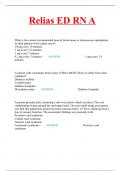
-
Relias ED RN A
- Exam (elaborations) • 18 pages • 2024
-
 a-grade
a-grade
-
- $10.99
- + learn more
Relias ED RN A What is the current recommended dose of intravenous or intraosseous epinephrine in adult patients with cardiac arrest? 10 mg every 10 minutes 1 mg every 3-5 minutes 1 mg every 7 minutes 0.1 mg every 2 minutes - ANSWER 1 mg every 3-5 minutes A patient with a traumatic brain injury (TBI) is MOST likely to suffer from what condition? Diabetes mellitus Cerebral palsy Diabetes Insipidus Myxedema coma - ANSWER ...
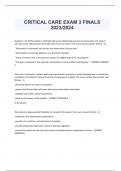
-
CRITICAL CARE EXAM 3 FINALS 2023/2024
- Exam (elaborations) • 54 pages • 2023
-
 TIFFACADEMICS
TIFFACADEMICS
-
- $17.99
- 1x sold
- + learn more
CRITICAL CARE EXAM 3 FINALS 2023/2024 Question 1 of 10The patient is admitted with severe abdominal pain due to pancreatitis. The patient asks the nurse, "What causes this? Why does it hurt so much?" The nurse should answer: (Points : 1) "Pancreatitis is extremely rare and no one knows why it causes pain." "Pancreatitis is caused by diabetes; you should be checked." "Injury to certain cells in the pancreas causes it to digest (eat) itself, causing pain." "The pain is localiz...
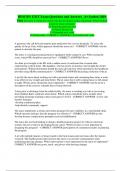
-
HESI RN EXIT Exam Questions and Answers_ A+ Graded 100% Pass The nurse is caring for a client who has developed cardiac tamponade. Which finding would the nurse anticipate? A) Widening pulse pressure B) Pleural friction rub C) Distended neck veins D) Brad
- Exam (elaborations) • 52 pages • 2024
-
 BrooksOfBliss
BrooksOfBliss
-
- $20.99
- 1x sold
- + learn more
HESI RN EXIT Exam Questions and Answers_ A+ Graded 100% Pass The nurse is caring for a client who has developed cardiac tamponade. Which finding would the nurse anticipate? A) Widening pulse pressure B) Pleural friction rub C) Distended neck veins D) Bradycardia - CORRECT ANSWER-C) Distended neck veins A pt presses the call bell and requests pain medication for a severe headache. To assess the quality of the pt. Pain, which approach should the nurse use? - CORRECT ANSWER-Ask the patien...
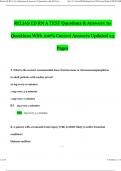
-
Relias ED RN A Test 2024 Questions & Answers | 70 Questions with 100% Correct Answers | Verified | Updated 2024 | 23 Pages
- Exam (elaborations) • 38 pages • 2024
-
 NurseFerian
NurseFerian
-
- $13.49
- + learn more
Relias ED RN A Test 2024 Questions & Answers | 70 Questions with 100% Correct Answers | Verified | Updated 2024 | 23 Pages What is the current recommended dose of intravenous or intraosseous epinephrine in adult patients with cardiac arrest? 10 mg every 10 minutes 1 mg every 3-5 minutes 1 mg every 7 minutes 0.1 mg every 2 minutes - 1 mg every 3-5 minutes A patient with a traumatic brain injury (TBI) is MOST likely to suffer from what condition? Diabetes mellitus Cerebral palsy Diabetes Insipidus...
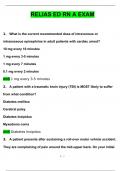
-
2024 Relias ED RN A Exam questions & Answers 2024 ( A+ GRADED 100% VERIFIED)
- Exam (elaborations) • 38 pages • 2024
-
 NurseFerian
NurseFerian
-
- $12.49
- + learn more
1. What is the current recommended dose of intravenous or intraosseous epinephrine in adult patients with cardiac arrest? 10 mg every 10 minutes 1 mg every 3-5 minutes 1 mg every 7 minutes 0.1 mg every 2 minutes ANS 1 mg every 3-5 minutes 2. A patient with a traumatic brain injury (TBI) is MOST likely to suffer from what condition? Diabetes mellitus Cerebral palsy Diabetes Insipidus Myxedema coma ANS Diabetes Insipidus 3. A patient presents after sustaining a roll-over motor vehicle ac...
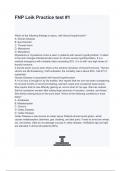
-
FNP Practice Questions and Answers
- Exam (elaborations) • 41 pages • 2024
- Available in package deal
-
 Studyclock
Studyclock
-
- $13.49
- + learn more
FNP Practice Questions and Answers Which of the following findings is assoc. with thyroid hypofunction? A. Graves Disease B. Eye Disorder C. Thyroid storm D. Myxedema D. Myxedema Myxedema or myxedema coma is seen in patients with severe hypothyroidism. It refers to the skin changes (thickened skin) seen in chronic severe hypothyroidism. It is a medical emergency with mortality rates exceeding 20%. It is tx with very high doses of thyroid hormone. A thyroid storm occurs when there is ...
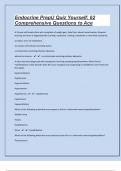
-
Endocrine PrepU Quiz Yourself: 62 Comprehensive Questions to Ace "Quiz Yourself Success Simplified: Comprehensive Answers for Your Exams
- Exam (elaborations) • 15 pages • 2024
-
 jackline98
jackline98
-
- $7.99
- + learn more
A 35-year-old female client who complains of weight gain, facial hair, absent menstruation, frequent bruising, and acne is diagnosed with Cushing's syndrome. Cushing's syndrome is most likely caused by: an inborn error of metabolism. an ectopic corticotropin-secreting tumor. a corticotropin-secreting pituitary adenoma. adrenal carcinoma. - ️️a corticotropin-secreting pituitary adenoma. A client has been diagnosed with myxedema from long-standing hypothyroidism. What clinical manif...
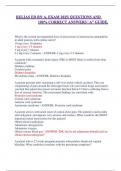
-
RELIAS ED RN A, EXAM 2025 QUESTIONS AND 100% CORRECT ANSWERS
- Exam (elaborations) • 25 pages • 2025
- Available in package deal
-
 Mboffin
Mboffin
-
- $15.89
- + learn more
RELIAS ED RN A, EXAM 2025 QUESTIONS AND 100% CORRECT ANSWERS What is the current recommended dose of intravenous or intraosseous epinephrine in adult patients with cardiac arrest? 10 mg every 10 minutes 1 mg every 3-5 minutes 1 mg every 7 minutes 0.1 mg every 2 minutes - ANSWER- 1 mg every 3-5 minutes A patient with a traumatic brain injury (TBI) is MOST likely to suffer from what condition? Diabetes mellitus Cerebral palsy DiabetesInsipidus Myxedema coma - ANSWER- Diabetes Insipid...

$6.50 for your textbook summary multiplied by 100 fellow students... Do the math: that's a lot of money! Don't be a thief of your own wallet and start uploading yours now. Discover all about earning on Stuvia


